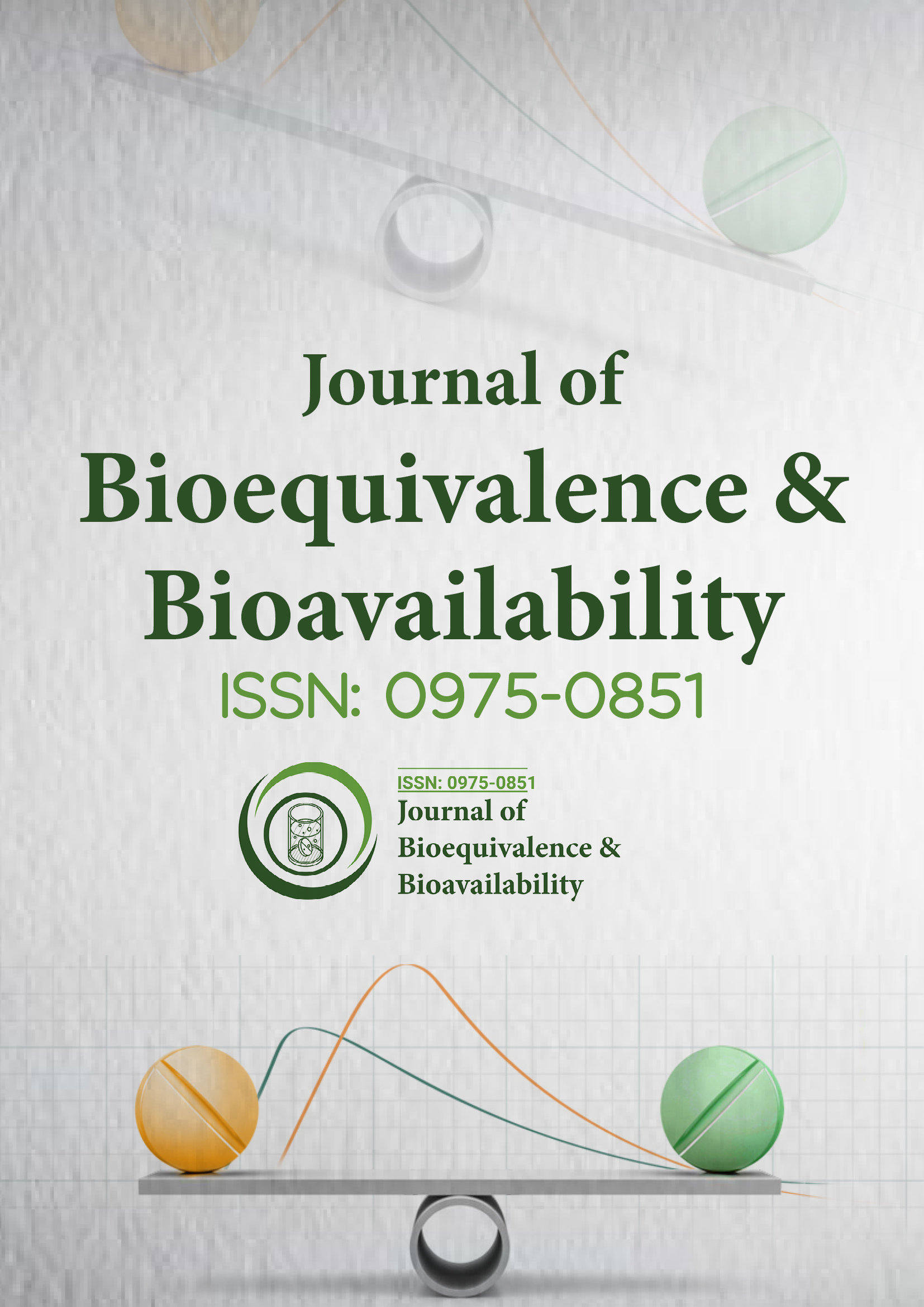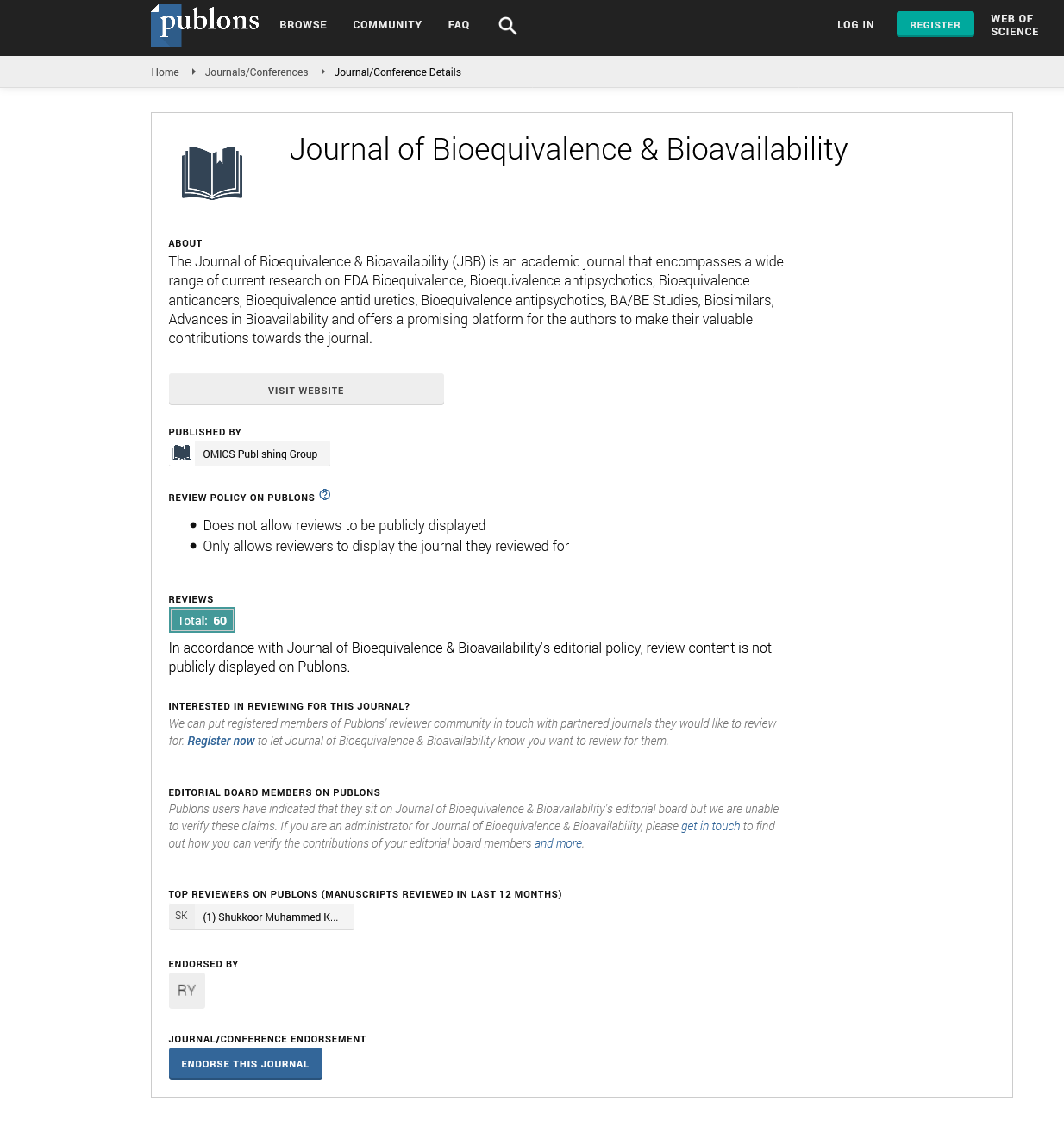Indexed In
- Academic Journals Database
- Open J Gate
- Genamics JournalSeek
- Academic Keys
- JournalTOCs
- China National Knowledge Infrastructure (CNKI)
- CiteFactor
- Scimago
- Ulrich's Periodicals Directory
- Electronic Journals Library
- RefSeek
- Hamdard University
- EBSCO A-Z
- OCLC- WorldCat
- SWB online catalog
- Virtual Library of Biology (vifabio)
- Publons
- MIAR
- University Grants Commission
- Geneva Foundation for Medical Education and Research
- Euro Pub
- Google Scholar
Useful Links
Share This Page
Journal Flyer

Open Access Journals
- Agri and Aquaculture
- Biochemistry
- Bioinformatics & Systems Biology
- Business & Management
- Chemistry
- Clinical Sciences
- Engineering
- Food & Nutrition
- General Science
- Genetics & Molecular Biology
- Immunology & Microbiology
- Medical Sciences
- Neuroscience & Psychology
- Nursing & Health Care
- Pharmaceutical Sciences
Commentary - (2025) Volume 17, Issue 1
The Role of Physiologically Based Pharmacokinetic Modeling in Bioequivalence Testing of Complex Generics
Jon Kimber*Received: 03-Feb-2025, Manuscript No. JBB-24-28944; Editor assigned: 05-Feb-2025, Pre QC No. JBB-24-28944 (PQ); Reviewed: 18-Feb-2025, QC No. JBB-24-28944; Revised: 25-Feb-2025, Manuscript No. JBB-24-28944 (R); Published: 04-Mar-2025, DOI: 10.35248/0975-0851.25.17.621
Description
Bioequivalence testing stands at the intersection of pharmacological science, regulatory policy, and public health. Its purpose is to establish therapeutic equivalence between a generic drug and its Reference Listed Drug (RLD), thereby assuring healthcare providers and patients that the generic will perform similarly in clinical settings. Over the years, bioequivalence testing methods have evolved in sophistication, scope, and scrutiny, reflecting both technological advances and growing appreciation of the nuances in drug behavior across patient populations. Despite being grounded in a clear objective—proving that two pharmaceutical products do not differ significantly in the rate and extent of drug absorption—the methodologies applied in bioequivalence testing are complex, multi-layered, and not without limitations.
Bioequivalence studies are most commonly carried out in healthy volunteers under controlled, fasting conditions, using a randomized, two-period, two-sequence crossover design. This design helps to minimize inter-subject variability by having each participant serve as their own control. However, such studies do not fully replicate the pharmacokinetic variability seen in diverse patient populations with comorbidities, concurrent drug therapies, or altered physiological states. For example, a drug that exhibits predictable absorption in a healthy individual may behave differently in a patient with gastrointestinal disorders, altered liver metabolism, or renal impairment. Therefore, while the controlled environment of such trials allows for precise measurements, it does not always offer a comprehensive understanding of real-world bioequivalence.
Beyond conventional pharmacokinetic assessments, bioequivalence testing methods have expanded to accommodate unique dosage forms and delivery mechanisms. For instance, locally acting gastrointestinal drugs, inhaled therapies, topical agents, and transdermal systems pose challenges that cannot be adequately addressed by systemic plasma concentrations alone. In such cases, alternative testing strategies are employed. For topicals, for example, dermatopharmacokinetic studies may be used to measure drug concentrations at or near the site of action. For inhaled products, in vitro methods such as cascade impaction and particle size distribution testing are paired with in vivo studies to demonstrate equivalence in drug deposition within the lungs. The development of such methodologies marks a significant evolution in the field, recognizing that systemic pharmacokinetics is not a one-size-fits-all solution for evaluating bioequivalence.
Another growing area of discussion is the concept of therapeutic equivalence versus statistical bioequivalence. While a drug may fall within the prescribed bioequivalence range statistically, it might not elicit the same therapeutic response in practice. This is particularly relevant for drugs with narrow therapeutic indices or complex pharmacodynamics. Therapeutic Drug Monitoring (TDM), real-world evidence, and pharmacovigilance data can help bridge this gap, offering post-marketing insights that complement pre-approval bioequivalence testing. In the future, a more integrated approach combining pharmacokinetics, pharmacodynamics, and clinical outcome data may become the norm, especially for high-risk drugs.
Regulatory harmonization remains a pivotal issue in bioequivalence testing. While agencies like the FDA and EMA have established rigorous and detailed bioequivalence requirements, standards vary significantly across countries. In many low- and middle-income regions, limited infrastructure and resources result in inconsistent implementation of bioequivalence testing, opening the door to substandard or counterfeit generics. These discrepancies not only threaten patient safety but also undermine global confidence in the quality of generics. International collaborations and initiatives like the World Health Organization's Prequalification Program aim to standardize bioequivalence assessment and raise global quality standards, but progress is uneven and often influenced by local economic and political factors.
Public perception and trust are also crucial aspects of the bioequivalence landscape. Despite regulatory assurances, skepticism about the efficacy and safety of generic drugs persists among patients and even healthcare providers. Negative anecdotal experiences, media coverage, or variability in therapeutic outcomes can all contribute to this mistrust. Transparent communication about the rigor and reliability of bioequivalence testing methods, along with ongoing education of clinicians and patients, is essential to address these concerns. Moreover, policy measures such as requiring substitution only for generics proven to be therapeutically equivalent or interchangeable can further support patient confidence.
Citation: Kimber J (2025). The Role of Physiologically Based Pharmacokinetic Modeling in Bioequivalence Testing of Complex Generics. J Bioequiv Availab. 17:621.
Copyright: © 2025 Kimber J. This is an open-access article distributed under the terms of the Creative Commons Attribution License, which permits unrestricted use, distribution, and reproduction in any medium, provided the original author and source are credited.

